Google, in partnership with Sterling Brands and Ipsos, recently conducted a study to understand how U.S. consumers interact with media in their day-to-day lives. Not surprisingly, the majority of the research participants use smartphones, tablets, computers and TVs to find and use digital content.
And they're not just using one device or another; consumers frequently use a combination of devices to find information and complete tasks.
All The World's A Screen
The study finds that 90% of media interactions are screen-based, and we spend almost 4.5 hours of our leisure time in front of a screen.
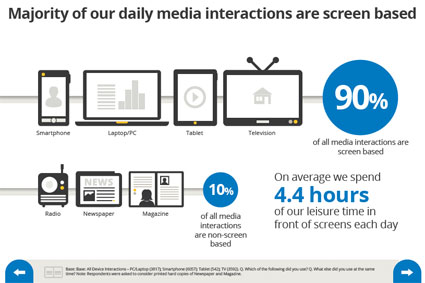
Source: Google
Smartphones, laptops/desktop computers, tablets, and TVs are the primary devices used to consume media.
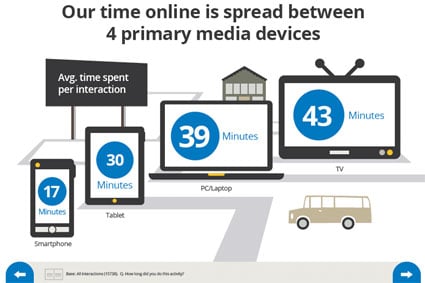
Source: Google
What This Means For Your Business
Evaluate your marketing strategy
Businesses need to take a good look at their marketing strategy and evaluate what works, what doesn’t work, and where new opportunities lie. Just because that radio spot has “always worked” doesn’t mean you should avoid any sort of digital marketing activity. Really, in this day and age, you can’t afford to ignore it. Digital is no longer optional. It’s now an essential piece of your marketing toolkit.
Supplement traditional marketing with digital marketing
Digital doesn't have to displace your current strategy, and it doesn't have to be "all or nothing." You can use digital marketing to complement your offline activities, and you can add new strategies over time.
Take an HVAC contractor, for example. ABC Heating & Cooling has done pretty well with print advertising; now it's time to throw multi-screen marketing into the mix. Perhaps their next newspaper ad features a unique URL that people can visit to download an exclusive "Fall HVAC tune-up" coupon. Next year, ABC Heating & Cooling ramps up their online offer. In addition to a coupon, people could also download the ABC Heating & Cooling mobile app, which is chock-full of tips to maintain an HVAC system's efficiency and how-to guides that walk customers through basic HVAC maintenance.
All About the Context, Context, Context
People use different devices in different situations; it all depends on where we are, what we need to do, and the time we need to get things done.
For example, smartphones are a go-to for on-the-go folks. They also get used at home. People tend to use a smartphone in short spurts, when they need a fast, convenient way to find information.
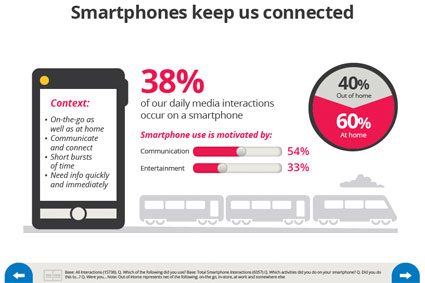
Source: Google
Now, consider a laptop or desktop computer. They are used at home and at work. Computer use is expected to keep us on task and informed.
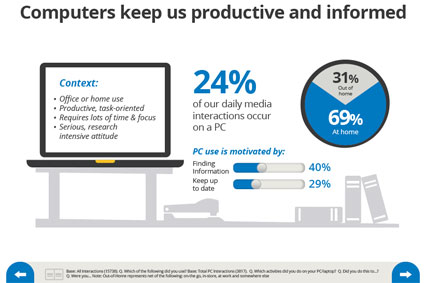
Source: Google
What This Means For Your Business
Plan online content around situations and devices
Your content needs to be able to adapt to different situations, mindsets, devices. What are you doing to ensure that your customers receive relevant information in an effortless, efficient manner?
Let's revisit ABC Heating & Cooling. They have created a website. It provides general information on their services, their HVAC technicians, the company's history, their community service efforts, and how to contact the company. The website also features a coupon page, an email newsletter archive and a blog. The website's main focus is general education and providing helpful resources.
ABC decides to create a mobile website as well. They've received feedback from their customers and prospects that smartphones and the like are used to find a service provider in an "urgent" situation. The mobile website features streamlined content that puts ABC's contact information front and center. ABC also includes links to the services page, to help customers identify whether ABC Heating & Cooling can help; the coupons page, in the event they have an offer that will help the customer offset costs; and the blog, in case the customer needs to find an article and take action before ABC can get there.
ABC isn't drastically altering their existing content or crafting completely separate content for different platforms. Rather, they've evaluated all of their content and created a strategy to deliver the most pertinent information for the situation at hand.
Multi-Screen, Multi-Screen, Multi-Screen (To Every Action There're Multiple Devices)
The study identifies two main ways that people multi-screen:
- Sequential usage, which is defined as "moving from one device to another at different times to accomplish a task."
- Simultaneous usage, which is defined as "using more than one device at the same time for either a related or an unrelated activity."
In sequential multi-screening, smartphones are often the starting point for online activity; then, people typically finish their task on a PC.
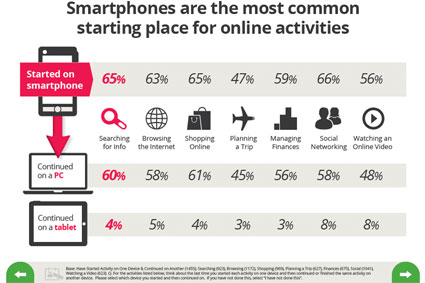
Source: Google
With simultaneous usage, there are three main device combinations: smartphone + TV; smartphone + laptop/desktop computer; laptop/desktop computer + TV.
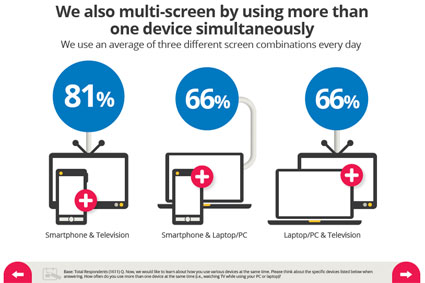
Source: Google
What This Means For Your Business
Provide a seamless experience across all digital platforms
You need to ensure that you provide a seamless experience for the consumer. For the sequential prospect, do you have options in place for them to save their progress on a form or in a shopping cart? Send or save content from your website? How can they easily and quickly pick up where they left off?
ABC Heating & Cooling may want to include a customer login center, where returning customers can place future work orders online. Jane Doe knows she needs ABC to visit her house, but she doesn't have enough time to finish the work order on her lunch break. She can start and save her request on her phone while at work. Then, when she gets home and has more time, Jane can finish and send the request.
For the simultaneous multi-screener, an integrated marketing approach is key. A TV ad could be used to drive initial interest in a new product or time-sensitive offer, and then drive customers to a website landing page that describes the product or special in more detail. ABC Heating & Cooling could also add a special call-to-action on their homepage as another way to promote this new product or offer.
What are you doing to maximize your marketing in a multi-screen world? Share your tips and advice (or questions!) in the comments.
Does your business need assistance marketing in the mobile space, or supplementing traditional marketing with online marketing? Contact us to see how we can help.









